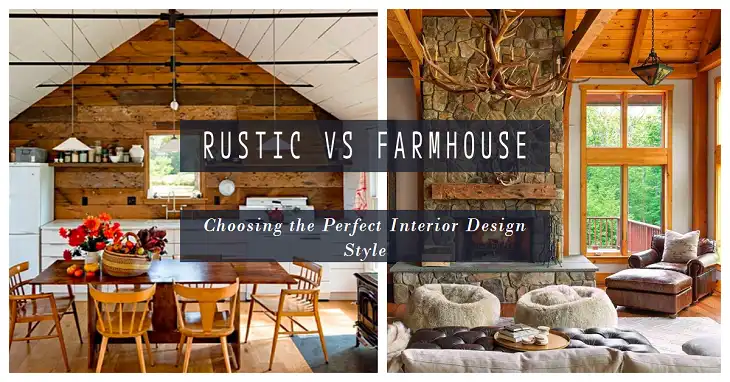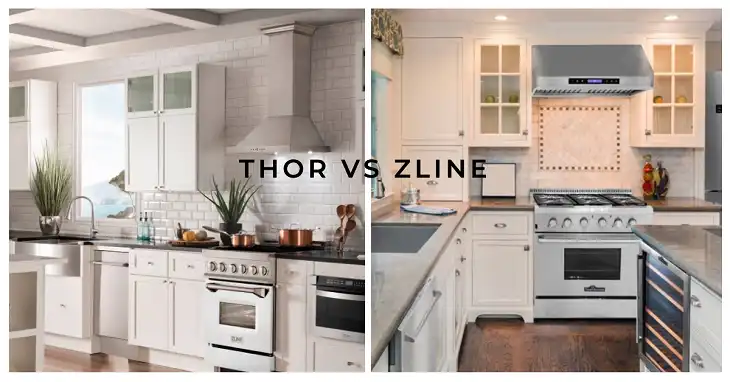Rustic vs Farmhouse: Which Interior Design Style Should You Go With

Rustic and farmhouse styles have surged in popularity over the past decade, with Pinterest searches for these terms increasing by 150% since 2015. But what exactly sets these two cozy aesthetics apart?
At their core, rustic design embraces the raw beauty of nature, while farmhouse style blends vintage elements with modern comfort. Both styles share a love for natural materials and a lived-in feel, but the devil is in the details.
Core Philosophy Behind Rustic & Farmhouse Designs
The philosophy behind rustic design is a deep connection to nature. It celebrates raw materials and the beauty of imperfection. A rustic home might feature a gnarly wooden beam or a rough-hewn stone fireplace, showcasing the inherent character of these elements.
Farmhouse style, while also appreciating natural materials, focuses more on nostalgia, comfort, and practical functionality. It’s about creating a warm, welcoming space that feels lived-in and loved. A farmhouse kitchen, for example, might feature a large apron-front sink and open shelving for easy access to everyday items.
Rustic vs Farmhouse: Key Characteristics
To help visualize the differences, let’s break down the key characteristics of each style:
| Aspect | Rustic | Farmhouse |
| Materials | Raw wood, stone, leather | Painted wood, galvanized metal, cotton |
| Textures | Rough, unrefined | Smooth with subtle distressing |
| Colors | Earth tones (browns, greens) | Neutrals (whites, creams) with pops of color |
| Furniture | Heavy, solid wood pieces | Mix of painted and natural wood |
| Decor | Nature-inspired (antlers, pine cones) | Vintage-inspired (old signs, enamelware) |
Table: Comparison of Rustic and Farmhouse Characteristics
Color Palettes
The color palette is one of the most noticeable differences between rustic and farmhouse styles. Rustic interiors typically embrace earth tones, with rich browns, deep greens, and warm grays dominating the space. These colors reflect the natural world and create a cozy, grounded atmosphere.
Farmhouse style, in contrast, often starts with a neutral base of whites and creams. This creates a light, airy feel that’s then accented with pops of color. Popular farmhouse accent colors include soft blues, sage greens, and warm yellows. These colors add personality while maintaining the clean, fresh look that farmhouse style is known for.

Image: Color palettes for farmhouse decor
Materials Comparison
Both styles make heavy use of natural materials, but the way these materials are treated differs significantly. In rustic design, you’ll find rough-hewn wood beams, natural stone fireplaces, and wrought iron accents. These materials are often left in their natural state or minimally treated to showcase their raw beauty.
Farmhouse style also incorporates wood and stone, but with a lighter touch. Wood might be painted white or distressed to give it a weathered look. Shiplap, a type of wooden board often used on walls, is a farmhouse staple. You’ll also see more use of galvanized metal, often in the form of light fixtures or decorative buckets.
A typical rustic living room might cost between $5,000 to $15,000 to furnish, depending on the quality of materials used. A farmhouse living room, on the other hand, might range from $3,000 to $10,000, as some elements can be more budget-friendly or even DIY.
Furniture Styles
When it comes to furniture, rustic style favors heavy, solid wood pieces. Think of a massive dining table made from a single slab of wood, or a chunky leather armchair. These pieces often showcase the natural grain and knots of the wood, celebrating its imperfections.
Farmhouse furniture tends to be a mix of painted and natural wood pieces, often with a distressed finish. A farmhouse dining set might feature a natural wood tabletop with painted white legs, surrounded by mismatched chairs in various shades of white and cream. The overall effect is more eclectic and collected over time.

Image: Farmhouse Furniture Style
Architectural Elements
The architectural elements in rustic and farmhouse styles can dramatically impact the overall feel of a space. In rustic homes, you’ll often find exposed wooden beams, stone fireplaces, and even log construction. These elements bring the outdoors in and create a strong connection to nature.
Farmhouse architecture, while also incorporating some natural elements, tends to be more refined. Shiplap walls, barn doors, and wide plank floors are common features. A farmhouse might also have a front porch with a swing, adding to its welcoming appeal.
Lighting Fixtures
Lighting plays a crucial role in setting the mood in both styles, but the fixtures themselves differ quite a bit. Rustic lighting often features wrought iron, antler chandeliers, or lantern-style fixtures. These pieces tend to be substantial and make a strong statement in the space.

Image: Rustic lighting fixture
Farmhouse lighting, while still often featuring metal, tends to be more delicate. Industrial-inspired pendants, mason jar lights, and vintage-style fixtures are popular choices. These fixtures often incorporate galvanized metal or painted finishes that complement the overall color scheme.
A rustic chandelier might cost anywhere from $300 to $2,000 or more, especially for custom pieces. Farmhouse lighting fixtures are often more affordable, with many options available in the $100 to $500 range.
Textiles and Fabrics
The textiles used in each style contribute significantly to their overall feel. Rustic interiors often feature heavy, textured fabrics like burlap, wool, and leather. These materials add warmth and coziness to the space.

Farmhouse style leans towards lighter, airier fabrics such as cotton and linen. You’ll often see subtle patterns like gingham or small florals. Quilts are a common feature in farmhouse bedrooms, adding both comfort and a touch of nostalgia.
| Rustic Textiles | Farmhouse Textiles |
| Burlap | Cotton |
| Wool | Linen |
| Leather | Quilted fabrics |
| Faux fur | Ticking stripe |
| Heavy knits | Light florals |
Table: Comparison of Textiles in Rustic and Farmhouse Styles
Decor and Accessories
The decor choices in rustic and farmhouse styles can really set them apart. Rustic decor often incorporates elements from nature, such as antlers, pinecones, or driftwood. You might see a large piece of artwork depicting a forest scene or mountains.

Image: Rustic living room decor
Farmhouse decor tends to be more eclectic and collected. Vintage signs, botanical prints, and wire baskets are common. Many farmhouse enthusiasts enjoy incorporating family heirlooms or flea market finds into their decor, adding personal touches throughout the space.
Room-by-Room Application
Let’s explore how these styles might be applied in different rooms of the house:
Living Room
A rustic living room might feature a large stone fireplace as the focal point, with chunky leather sofas and a coffee table made from a slice of tree trunk. The walls might be adorned with wildlife artwork or vintage outdoor equipment.
A farmhouse living room, in contrast, might have a brick fireplace painted white, with a reclaimed wood mantel. The furniture could include a slipcovered sofa in a light neutral color, accented with colorful throw pillows. A gallery wall of family photos in mismatched frames could add personal charm.
Kitchen
In a rustic kitchen, you might find open shelving made from thick wooden planks, supported by iron brackets. The countertops could be butcher block or rough-cut stone. Copper pots and cast iron skillets might hang from a pot rack, adding both functionality and decorative appeal.

Image: A combination of rustic and farmhouse-style kitchen
A farmhouse kitchen often features white cabinets, perhaps with some glass-front doors to display dishes. The iconic farmhouse (or apron-front) sink is a must-have, often in white porcelain. Subway tile backsplashes and open shelving displaying vintage pitchers or mason jars complete the look.
Bedroom
A rustic bedroom might feature a bed frame made from logs or rough-hewn timber. Faux fur throws and pillows add texture and warmth. The lighting might come from antler chandeliers or wrought iron sconces.
In a farmhouse bedroom, you’re more likely to see an iron bed frame, perhaps painted in a soft color. The bedding might include a quilt passed down through generations, layered with crisp white sheets. Soft, gauzy curtains and distressed wooden side tables complete the cozy, nostalgic feel.
Mixing Rustic and Farmhouse Elements
While we’ve focused on the differences between rustic and farmhouse styles, it’s important to note that they can be beautifully combined. Many homeowners enjoy blending elements from both styles to create a unique, personalized space.
For example, you might pair a rustic wooden dining table with farmhouse-style chairs painted white. Or you could use farmhouse-inspired shiplap on the walls of a room with rustic wooden beams on the ceiling. The key is to maintain a balance and ensure that the elements you choose work harmoniously together.
How to Choose the Right Style for Your Home and Taste
Ultimately, the choice between rustic and farmhouse style (or a blend of both) comes down to personal preference and the architecture of your home. Consider these questions:
- Do you prefer a more rugged, nature-inspired look (rustic) or a lighter, more refined aesthetic (farmhouse)?
- What’s the setting of your home? A cabin in the woods might lend itself more to rustic style, while a home in a rural or suburban area might be perfect for farmhouse style.
- How much maintenance are you willing to do? Rustic style might require more care for natural materials, while farmhouse style might need more frequent cleaning of light-colored surfaces.
- What’s your budget? While both styles can be adapted to different price points, rustic style often involves more expensive, solid wood pieces.
Remember, there’s no right or wrong answer. The best style is the one that makes you feel comfortable and reflects your personal taste.
Final Words
Rustic and farmhouse styles both offer warm, inviting atmospheres that can turn a house into a home. While rustic style embraces the raw beauty of nature with its use of rugged materials and earthy tones, farmhouse style blends vintage charm with modern comfort through light colors and practical design.
Whether you’re drawn to the cozy, cabin-like feel of rustic design or the airy, nostalgic appeal of farmhouse style, both offer timeless aesthetics that can be adapted to suit your personal taste and lifestyle. And remember, design rules are meant to be broken – don’t be afraid to mix elements from both styles to create a space that’s uniquely yours.






